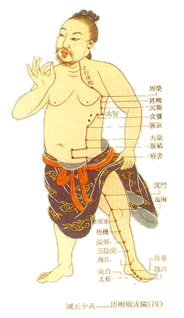

Traditional Chinese medicine (TCM) also known simply as Chinese medicine or traditional Oriental medicine, is the name commonly given to a range of traditional medical practices used in China that have developed over the course of several thousand years of history.
Chinese medicine principally employs a method of analysis and synthesis, inquiring on a macro-level into the internal systems of the human body and their mutual relationships with the internal and external environment in an attempt to gain an understanding of the fundamental laws which govern the functioning of the human organism, and to apply this understanding to the treatment and prevention of disease, and health maintenance.
TCM is rooted in a unique, comprehensive and systematic theoretical structure which includes the Theory of the Five Elements, the human body Meridian system and Yin-Yang. Treatment is conducted with reference to this philosophical framework.
In modern days, TCM is broken down into five branches. Most TCM practitioners use modalities from either one or two of the five branches during a treatment session, and give the patient enough information about the other modalities in case there is interest. The five branches of Chinese Medicine are:
- » Acupuncture
- » Chinese herbology
- » Qi Moving Excercises
- » Nutrition

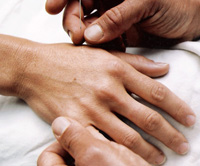
Without a doubt the most well known techniques of Traditional Chinese Medicine (TCM) is acupuncture. Although, the term acupuncture in the west has almost become a synonym for Traditional Chinese Medicine, it is only one of the many techniques under the TCM umbrella.
Following the general theory of Traditional Chinese Medicine in that proper physiological function and health depend on the circulation of nutrients, substances and energy called Chi (pronounced "chee") through a network of "channels" or "meridians", acupuncture attempts to unblock the channels when they become congested. This is done by the insertion of very thin needles in very specific points on the body.
Modern acupuncture needles are stainless steel, between one-half and three inches long, ultra-fine and quite flexible. They are pre-sterilized, nontoxic and disposable (single use). When the needles are tapped into the skin, there may not be any sensation. Much depends on the location (hands and feet tend to be more sensitive), the condition being treated and the acupuncturist's technique. Needles are typically placed in several acu-points and are usually left in about 20-40 minutes. The goal is to normalize the circulation of Chi and Blood by stimulating the energy point, which encourages the body's natural healing process. Stimulation can be done by rotating the needles manually or attaching electrodes to send a weak electric current through the needles (link to electro acupuncture page).
The number of treatments depends upon the duration, severity and nature of the patient's health condition. Two or three treatments may be sufficient for an acute condition, while a series of 5 to 15 treatments may be needed to resolve chronic conditions. Some degenerative conditions may require ongoing treatments over a long period of time.
It is not recommended to have an acupuncture treatment if you are very hungry or extremely tired. Some bruising may occasionally occur after needling. If you have a bleeding disorder or are on blood thinning medications, you should inform your acupunc-turist before undergoing treatment. If you are pregnant or have a pacemaker, tell the acupuncturist so that appropriate herbs and acu-points can be chosen.
Some of the most common disorders treated by acupuncture include: addictions, allergies, ankle swelling, arm and shoulder pain, arthritis, asthma, attention deficit disorder, back pain, bed wetting, blood pressure (high or low), bronchial conditions, bursitis, carpal tunnel syndrome, circulation (poor), colds, colitis, colon (spastic), constipation, cough (chronic), depression, detox for chemical dependency, diarrhea, discs problems, diverticulitis, dizziness (vertigo), emphysema, fatigue (chronic), feet, (cold), fibromyalgia, flu, gall bladder disorders, gas, gynecological dysfunction, hay fever, headache, heart problems, hemorrhoids, hiccoughs, hip pain, immune system deficiency, indigestion, infertility, injuries, insomnia, joint pain, kidney problems, knee pain, leg pain (cramps, tingling, numbness), liver problems, neck (stiff, painful), nervousness, neuralgia, pain, pleurisy, pre menstrual syndrome, prostate problems, rheumatism, sciatica, shingles, shoulder pain, sinus problems, skin problems, sport injuries, stomach problems, throat (sore), thyroid conditions, ulcers (stomach), urinary problems, and whiplash.
References:
- 1. Acupuncture A Comprehensive Text
- 2. The Foundations of Chinese Medicine
- 3. Chinese Acupuncture and Moxibustion

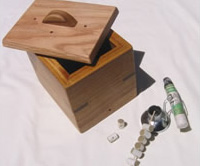
Moxibustion is an ancient Eastern tradition of heat therapy that is as old as acupuncture. In fact, the term acupuncture in Chinese is formed by two words; "Zhen Jiu". The word "zhen" means needle and the word "jiu" means moxibustion. Moxibustion and acupuncture have been traditionally used as a pair since the beginning of Traditional Chinese Medicine (TCM), and continuos to be a very powerful combination for most practitioners of TCM today.
Moxibustion involves heating up a particular acupuncture point by burning a very specific herb, Artemisia Vulgaris, or commonly known as "mugwort". This herb is chosen because of its very warming properties, and its pure yang nature, having the ability to restore the primary yang energy.
There are two main ways of doing moxibustion; direct and indirect. With direct moxibustion a small cone-shaped piece of the herb is placed on the desired acupuncture point and then burned. If the herb is allowed to burn all the way down to the skin causing a blister and many times a scar, the technique is called scarring moxibustion. On the other hand, if the herb is not allowed to completely burn, but just enough to create a strong heating sensation and then extinguished, the technique is called non-scarring moxibustion.
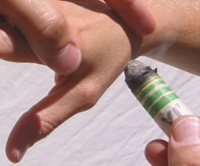
With indirect moxibustion the burning herb does not touch the skin. The most common type of indirect moxibustion is when a practitioner uses what is called a "moxa stick". The "stick", which roughly resembles the shape and size of a cigar, is made out of tightly rolled mugwort with sometimes small amounts of other herbs. The practitioner lights one end and holds it close to the area being treated causing a strong sensation of heat. Another type of indirect moxibustion is when the burning herb is insulated from the skin by a substance that sits between the skin and the burning herb. The type of substance used as insulator depends on what disorder is being treated. A slice of ginger, for example, is used for deficiency of the Stomach and Spleen which might manifest as diarrhea and abdominal pain. A slice of garlic is used for infections and poisonous insect bites, and salt is used to restore the yang energy.
Another popular technique of doing indirect moxibustion is with the use of acupuncture. With this technique a needle is inserted in the desired acupuncture point and then a small cone-shaped piece of herb is attached to the top of the needle. The herb is then ignited and as the herb burns the heat travels down the needle warming up the meridian.
From a TCM point of view, perhaps the most common indication for using moxibustion is the presence of Cold. Cold causes the Qi to slow down and in many cases to stagnate resulting in excruciating pain. Moxibustion warms up the meridians and expels cold. Achy, cold joints respond great to moxibustion. Moxibustion is also used to induce the smooth flow of Qi and Blood. This is done in areas where there is clearly a deficiency of Qi and Blood or on acupuncture points that are known for their ability to smooth the flow of Qi and Blood. Mugwort and heat are both warming and yang in nature, and when combined during moxibustion the result is a very powerful way of strengthening the yang energy. For this reason, moxibustion is widely used with patients that are weak and frail lacking yang energy. Ancient Chinese masters have been using moxibustion as prophylactic for thousands of years. By applying moxibustion on specific acupuncture points on a regular basis they are able to stay strong and healthy until the last day of their lives. Thus, moxibustion is used as a preventive treatment.
From a western medicine point of view, moxibustion increases the production of white blood cells. Studies have shown that white blood cell count begins to increase immediately after direct moxibustion, and reaches a peak 8 hours later. This peak is maintained for 24 hours. Similarly, studies have shown that moxibustion increases the production of red blood cells and hemoglobin. For subjects who had an average hemoglobin ratio of 78% just before direct moxibustion, the ratio increased steadily to reach a peak of 90% in eight weeks. Applying direct moxibustion continuously for 15 weeks, it takes 22 weeks for the red blood cell count to return to what it used to be before moxibustion. It also shows a substantial increase in the following blood components: the sedimentation rate of red blood cells, platelet count, the speed of blood coagulation, blood calcium, blood glucose count and the capacity to produce antibodies. Moxibustion has also been proven to improve the overall blood and lymph circulation.
Moxibustion should be avoided on the lower abdomen and sacral region of pregnant women. Also, no moxibustion should be applied on Excess or Heat syndromes (high fever). Scarring moxibustion should never be performed on the face, and no type of moxibustion should ever be applied on opened wounds.
Some of the most common disorders treated with moxibustion include asthma (direct moxa is best), arthritis (cold type - indirect with ginger), abdominal pain (indirect with ginger or salt), extreme diarrhea (indirect with salt in the navel), hernia pain (indirect with salt), impotence / premature ejaculation (indirect), vomiting (indirect with salt). Moxibustion has successfully been used to turn breech babies into a normal head-down position prior to childbirth. A landmark study published in the Journal of the American Medical Association in 1998 found that up to 75% of women suffering from breech presentations before childbirth had fetuses that rotated to the normal position after receiving moxibustion at an acupuncture point on the Bladder meridian.
References:
- 1. Chinese Acupuncture and Moxibustion
- 2. A practical dictionary of Chinese medicine
- 3. The treatment of external diseases with acupuncture and moxibustion
- 4. Acumoxa therapy

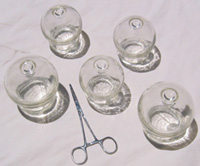
Cupping is an ancient Chinese practice where a cup is placed on the patient's skin. The pressure in the cup is removed, using different methods, creating a vacuum allowing the skin and superficial muscle layer to be drawn into the cup. From a Traditional Chinese Medicine point of view, this "pulling" effect on the skin stimulates the acupuncture point where the cup is placed. This regulates the flow of Qi and Blood, and helps to draw out and eliminate pathogenic factors such as Wind, Cold, Damp, and Heat. From a Western medicine point of view, the functioning of blood vessels within the muscles is activated in response to the stimulation of the subcutaneous capillary vessels created by the pulling effect of cupping. Thus the expansion of blood vessels in the muscles facilitates the flow of blood and has a remarkable effect on stiff muscles, and old injuries.
Although most practitioners use the traditional way of lighting up a cotton ball that has been soaked in alcohol and then inserting it and quickly removing it from the cup to create a vacuum, there are other ways of depressurizing the cups. In China, for example, almost every TCM hospital has electric cupping machines. With this system the cup is attached to the machine via a small suction tube where the suction strength and duration can all be adjusted and controlled electronically by the practitioner. The machines are expensive, bulky and are rarely used in the U.S. Another type of cup is the Screw-top cup. A handle on top of the cup is turned clockwise pulling a piston upwards which in turn creates the negative pressure necessary to do cupping. Valve cups are yet another type. Here the cup has a small valve at the top. Suction is created by attaching a small pump to the valve of the cup and pumping out the air. A popular cupping device for young children is the rubber cup. The practitioner simply squeezes the cup and places it on the desire acupuncture point. When the cup is released a vacuum is created. Generally, the cup is left in place for about 10 minutes (typical range is 5–15 minutes). The skin becomes reddened due to the congestion of blood flow. The cup is removed by pressing the skin along side it to allow some outside air to leak into it, thus equalizing the pressure and releasing it. Some bruising along the site of the rim of the cup is expected.
Besides the different types of cups, there are also different methods of doing cupping. The most popular methods are Weak, Medium, Strong, Moving and Needle. The first three methods have to do with the suction strength. Weak cupping is considered tonifying (versus sedating) and is mainly used when Qi and Blood are deficient. Weak cupping can also be used when there is stagnation (of Qi and/or Blood) along with deficiency. This is the gentlest method of all and is particularly suitable for debilitated adults, elderly patients and young children, especially those under 7 years of age. This is a great technique to tonify the Qi and Blood of the weak and frail. Medium cupping, also considered a tonifying technique, is the most common method used on patients with a relatively strong Qi, and children over 7 years of age. Joint pain, stress-related conditions, and children's ailments can all benefit from medium cupping technique. Strong cupping is the most draining technique of all. For this reason the patient must show excess signs. The pulse, tongue, and observation diagnosis must all indicate excess before using Strong cupping. This method is mainly used to move Qi and Blood and eliminate internal and external pathogenic factors and stagnation from patients with a relatively strong Qi. It is particularly beneficial in the treatment of Frozen Shoulder.

Sometimes the cup may be moved while the suction of skin is active, causing a regional pulling of the skin and muscle. This is known as Moving cupping. Moving cupping is the second most draining cupping technique (Strong cupping being the most draining), and as such it should only be used during excess conditions. It is usually done on the back (Bladder channel) after applying a thin coat of massage oil to reduce the amount of friction. Neurological conditions such as paralysis or post-stroke weakness can benefit from this cupping technique. Needle cupping, also a draining technique, is the combination of acupuncture and cupping. After the needle is inserted in the required acupuncture point, a cup with either medium or strong suction is applied on top of the needle. Painful joints that are red, swollen and hot can benefit from Needle cupping where there is a need to stop the pain and remove the excess pathogenic Heat at the same time.
Slight bruising is almost inevitable during cupping, especially during the first treatment where the stagnation of Qi and Blood are at the highest. The extent of the bruise depends on the length of the treatment time and the strength of the suction. The bruises should disappear between 7 to 10 days.
Some of the most common disorders treated with cupping include: abdominal pain, anemia, asthma, atrophy syndrome, back pain and sexual complaints, bed-wetting, chest pain, common cold and influenza, constipation, cough, dysmenorrhea, fevers, hypertension, muscular and joint pain, skin complaints, facial paralysis, tiredness, and varicose veins.

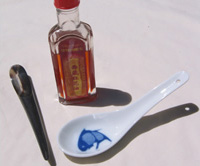
Like most of the different techniques used in Traditional Chinese Medicine (TCM), Gua Sha has been used in the East for literally thousands of years. Gua Sha, which could be translated to mean "the scraping of the skin until a reddish rash appears", embraces the belief that by scraping the surface of the skin, the toxins that have accumulated under the skin causing pain, will come to the surface and be eliminated.
The technique is used whenever there is pain, either acute or chronic. Some practitioners of TCM prefer Gua Sha over any other technique when there is aching, tenderness and/or a knotty feeling in the muscles. Gua Sha moves stagnant Qi and Blood, releases the Exterior mimicking sweating, and moves Fluids. From a Western medicine view, fluids containing metabolic waste that congest tissues and muscles are brought up to the surface and expelled. Gua Sha promotes circulation and normalizes metabolic processes.
Gua Sha is mainly done on the Yang surface of the body; the back, neck, shoulders, buttocks, and limbs. On occasion, Gua Sha is applied on the chest and abdomen. The area to be Gua Sha-ed is first lubricated with massage oil. The skin is then rubbed or scraped (Gua) with a round-edged instrument until a reddish and elevated millet-like skin rash (Sha) appears. If there is no Blood stasis the skin will only turn pink. A very common instrument in Asian countries is a porcelain soupspoon. The strokes are always from top to bottom, and on the back always away from the spine. On the chest the sternum is done very lightly and then following the contour of the ribs. On women, the breast tissue is avoided. When treating the shoulders and upper arms it is important to do the back and scapula area first.
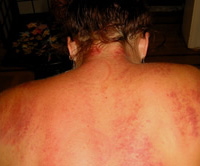
The color that the skin turns when being scraped (Sha) is both diagnostic and prognostic. A very light color Sha indicates deficiency of Blood. A dark or purple Sha indicates Blood stasis, and a dark red Sha can indicate Heat. The Sha in a well-balanced person should fade in 2 to 4 days. If the fading is slower it indicates poor circulation which could be due to a deficiency of Blood, Qi, or Yang.
After a Gua Sha treatment it is important to stay away from the sun and avoid cold drinks, coffee, and sour foods. Also, the patient should abstain from alcohol, drugs, fasting, hard labor and sex. Warm drinks are recommended, and in case of excessive tenderness a warm bath with mustard powder has been proven to be beneficial.
In most cases the patient feels an immediate shift in their condition particularly in their pain or sense of constrain. In addition to resolving musculo-skeletal pain, Gua Sha is used to treat, as well as prevent, common cold, flu, bronchitis, asthma as well as any chronic disorder involving pain (Qi and Blood stagnation). Another indication as to when to use Gua Sha is when normal finger pressure on a patient's skin causes blanching that is slow to fade.
References:
- 1. Gua Sha: A Traditional Technique for Modern Practice, Arya Nielsen
- 2. Gua Sha Video Training, Dennis Greenlee

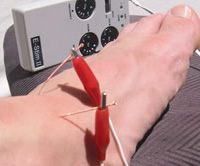
Electro-Acupuncture is perhaps the most modern technique used in acupuncture today. Introduced in China in the 1930's, after the Communist Party assumed power, electro-acupuncture is now widely used by acupuncturists through out the world.
This technique is very similar to regular acupuncture. It is used for mostly the same diseases and uses the same acupuncture points. The main difference is that it uses electric current instead of hand manipulation to obtain a stronger needle sensation.
Historically in China the needles were often hand manipulated at a frequency of 200 turns per minute, giving a similar effect to the low frequency of 2 to 4 Hertz obtained today with an electro-acupuncture device. Needless to say it would take a lot of practice to hand stimulate a needle at a rate of 200 turns per minute, but it would also limit the acupuncturist to doing one, or at the most, two needles at the same time. With electro-acupuncture the acupuncturist can increase/decrease the frequency, do many points at the same time, stimulate the point for a longer amount of time, and free the acupuncturist to prepare the herbal formula for that patient or simply see another patient.
As with regular acupuncture, the first step after inserting the needle is to try to obtain the Chi - the mild pleasant-ache sensation that has been described as "an electric shock". After the needle has been inserted and Chi obtained, small wire clips are attached to the needle. To make the electricity flow you must have two leads connected to two different needles. The device is then turned on and electricity is passed through. At the beginning, the electric potential should be zero and the current only gradually increased to as to monitor the patient's reaction. Once the desired stimulation has been reached the needles are left alone for awhile. After about 10 minutes the patient becomes accustomed to the electric stimulation (the feeling of stimulation declines) so the current once again is gradually increased. The entire electro-acupuncture treatment takes between 30 to 45 minutes increasing the stimulation every 10 to 15 minutes.
The frequency and the type of wave selected are critical for a quick recovery. Most electro-acupuncture instruments come equipped with a frequency and wave regulator. A low frequency can range from 2 to 4 Hertz, where a high frequency can range from 50 to 200 Hertz (tetanic spastic contractions can be expected above 20 Hertz). The three main waves used are Continuos, Discontinuos and Dens-Disperse. A Continuos regular wave is best for pain and spasm. A Discontinuos wave strengthens deficiency, and a Dense-Disperse wave (when the pulses alternate between quick and slow) is best for paralysis and numbness. Excess is best drained by using a continuos wave.
Electro-acupuncture provides the option of performing this technique without the use of needles. Flexible pads, consisting of electroconductive carbon, are adhered to the skin over the site of pain. Since the pads spread over a wider surface area than the needles, and the resistance is greater through the pads to the skin than the needles to the skin, a higher current/voltage is used with this application of electro-acupuncture.
Because of its strong stimulation, electro-acupuncture is seldom used when only a mild stimulation is needed. Some of the most common disorders treated with electro-acupuncture are: pain, spasm, muscular tension, atrophy, numbness, sprains, and paralysis. At high frequency electro-acupuncture can also be used for anesthesia.
Electro-acupuncture should not be used on patients with a history of heart disease or that have a pacemaker. The electrical path should not cross the heart. The Federal Drug Administration (FDA) does not permit the use of electrical stimulation around the head or ears.
Reference:
- 1. Acupuncture, A Comprehensive Text
- 2. A Practical Dictionary of Chinese Medicine
- 3. The Treatment of External Diseases With Acupuncture and Moxibustion

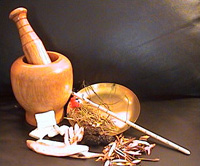
Herbal medicine, one of the five branches of Traditional Chinese Medicine (TCM) - Acupuncture, Qi Gong and Nutrition being the other four - is considered by many TCM practitioners a key component of every treatment. Sometimes supplementing an acupuncture treatment, and other times prescribed instead of acupuncture, herbal medicine has been part of TCM for thousands of years.
The earliest written record on Chinese herbal medicine was discovered in 1973 in Hunan province in a burial site. The burial itself is dated precisely to 168 B.C. and the material, which was written on silk, appears to have been composed before the end of the third century B.C. The largest, clearest, and most important of these manuscripts, called Prescriptions for Fifty-two Ailments (Wu shi er bing fang), names over 250 medicinal substances. Although, the theoretical foundation of this medical work is fundamentally different from what we now regard as traditional Chinese medicine, the substances themselves are comparable to those found in later materia medica and prescription manuals.
Over the years the materia medica has been increasing. China's first illustrated materia medica known as the Newly Revised Materia Medica, or as the Tang Materia Medica, was the official pharmacopeia of the Tang Dynasty (618 - 907 A.D.) containing 844 entries. During the Song Dynasty (960 - 1279 A.D.) the Materia Medica Arranged According to Pattern was the major materia medica containing 1,558 substances. China's most celebrated herbal book is the Grand Materia Medica by Li Shi-Zhen printed in 1596 A.D. It includes 1,892 substances: 1,173 from plants, 444 from animals, and 275 minerals. It has been translated into numerous languages. This tradition continues into the modern era with the publication in 1977 of the Jiangsu College of New Medicine's monumental twenty-five year project entitled Encyclopedia of Traditional Chinese Medicinal Substances. This book contains 5,767 entries and is the definite compilation of China's herbal tradition to date.
In Traditional Chinese Medicine every medicinal substance is seen as having at least a taste, a temperature and a direction. Other properties such as the channels or meridians of the human body in where the energy of that particular substance flows is also discussed. The taste of a medicinal substance partly determines its therapeutic function. Five tastes are recognized in Chinese medicine: acrid, sweet, bitter, sour and salty. Substances that have none of these tastes are said to be bland. Acrid substances disperse and move (pathogens), sweet substances tonify, harmonize and are sometimes also thought to moisten. Bitter substances drain and dry. Sour substances are astringent and prevent or reverse the abnormal leakage of fluids and energy. Salty substances purge and soften, and bland substances leech out dampness and promote urination. Every medicinal substance also has a temperature; a heating or cooling energy which is a natural component of that particular substance. Since various degrees of hot and cold exist amongst the different substances, Chinese medicine categorizes them into five groups: hot, cold, warm, cool, and neutral. Understanding the temperature of the different medicinal substances becomes critical when trying to balance a disharmony. It is said that Hot diseases must be cooled down and Cold diseases must be warmed up. For example, if there is already heat in the body, taking a warm-natured substance will create more heat increasing the disharmony already present. All medicinal substances have a functional tendency to move in one of four directions in the body: rise, fall, float, or sink. This tendency is indicative of the types of clinical situations in which it can be effectively used. For example, substances that rise and float primarily move upward and outward and can be used to promote sweating, disperse Cold, expel Wind, and raise the Yang. Substances that fall and sink primarily move downward and inward and can be used to redirect Rebellious Chi, calm wheezing, prevent abnormal loss of Fluids, and anchor the ascending Yang.
A combination of the properties listed above, and some other characteristics of the different medicinal substances, allows TCM to organize all the substances into categories. Most medicinal substances can be placed in one of eighteen categories. Some categories have several sub-categories. For example, the Tonifying category, a group of medicinal substances that is used to strengthen or supplement an area or process of the body that is insufficient or weakened, has four sub-categories: Tonify Chi, Tonify Blood, Tonify Yin, and Tonify Yang.
Although, a single medicinal substance is sometimes prescribed to treat a disorder, the combination of medicinal substances is a much more common practice of using Chinese herbal medicine. Formulas, the combination of several medicinal substances, are not just a collection of medicinal substances in which the actions of one herb are simply added to those of another in a cumulative fashion. They are complex recipes of interrelated substances, each of which affects the actions of the others in the formula. The ingredients in a formula are given ranks like in the old traditional Chinese society. The King (or Emperor) ingredient is the substance in the formula that has the greatest effect upon the disease. The Deputy ingredient has one of two functions: to aid the King ingredient in addressing the main condition, or to directly address a secondary condition being treated. The Assistant ingredients could have one of three functions: to reinforce the action of the King ingredient, to reduce any toxic or harsh qualities of the King or Deputy ingredients, or to act in an opposite way to that of the King ingredient in treating intricate, serious conditions. The Envoy ingredients have one of two functions: to direct the formula's various actions towards a certain channel or part of the body, or to harmonize and coordinate the actions of the other ingredients in the formula.
There are a number of ways of administering Chinese herbal medicine. Decoctions, literally soups, are by far the most common form in which traditional Chinese medicine is taken in China. It involves the boiling in water of the raw medicinal substances in a nonmetallic pot for about 45 minutes. Although, it is one of the most effective ways of administering Chinese herbal medicine, there is a great deal of resistance in the United States. This is due to the fact that they are time consuming to prepare, can make the entire house smell strange, and are expensive compared to some other forms of administration. A more popular method of administering Chinese herbal medicine in the west is powders. Powders are a readily absorbable, convenient, and easily stored form of medicinal preparation whose rate of medicinal action is between that of decoctions and pills. Pills are produced by combining the fine powder of pulverized medicinal substances with a viscous medium. From a functional perspective, pills are usually mild and slow in action.
Traditional Chinese medicinal substances are in general very safe and easy to use. Some medicinal substances (strong Chi-moving substances) are contraindicated during pregnancy since they can cause miscarriage.
Reference:
- 1. Chinese Herbal Medicine - Materia Medica, Bensky & Gamble, revised edition 1993
- 2. Chinese Herbal Medicine - Formulas & Strategies, Bensky & Barolet, 1990
- 3. The Traditional Chinese Medicine Formula Study Guide, Qiao Yi, 2000

